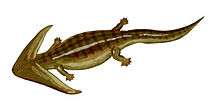Nectridea
| Nectrideans Temporal range: Late Carboniferous–Ufimian | |
|---|---|
 | |
| Life restoration of Diplocaulus. | |
| Scientific classification | |
| Kingdom: | Animalia |
| Phylum: | Chordata |
| Subclass: | †Lepospondyli |
| Node: | †Holospondyli |
| Order: | †Nectridea Miall, 1875 |
| Subgroups | |
Nectridea is the name of an extinct order of lepospondyl amphibians from the Carboniferous and Permian periods, including animals such as Diplocaulus. In appearance, they would have resembled modern newts or aquatic salamanders. They had long, flattened tails to aid in swimming, and well-developed hind limbs, with a full set of five toes each. The fore limbs were somewhat reduced, however, and like modern amphibians, typically had only four toes each.[1]
Taxonomy
Nectridean skull
- Order Nectridea
References
- Ahlberg, P. E. & Milner, A. R. 1994: The origin and early diversification of tetrapods. Nature: vol. 368, 7 April, pp. 507-514
- Anderson, J. S. 1998: Phylogenetic analysis of the Lepospondyli (Tetrapoda). Journal of Vertebrate Paleontology. Vol. 18, #3, Suppl. to #3, pp. 24A
- Carroll, R. L., 1988: Vertebrate paleontology and evolution. W. H. Freeman and company, New York, 1988, 698.
- Carroll, R. L., 1988: Appendix. 594-648. in Carroll, R. L., 1988: Vertebrate paleontology and evolution. W. H. Freeman and company, New York, 1988, 698.
- Carroll, R. L. 1996: Revealing the patterns of macroevolution. Nature: vol. 381, 2 May, pp. 19-20
- Clack, J. A., 1998: A new Early Carboniferous tetrapod with a mélange of crown-group characters. Nature: vol. 394, 2 July, pp. 66-69
- Shubin, N., 1998 [preview]: Evolutionary cut and paste. Nature: vol. 394, 2 July, pp. 12-13
- Vallin, G. & Laurin, M., 2004: Cranial morphology and affinities of Microbrachis, and a reappraisal of the phylogeny and lifestyle of the first amphibians. Journal of Vertebrate Paleontology: Vol. 24, #1, pp. 56-72
External links
This article is issued from Wikipedia - version of the 11/28/2016. The text is available under the Creative Commons Attribution/Share Alike but additional terms may apply for the media files.